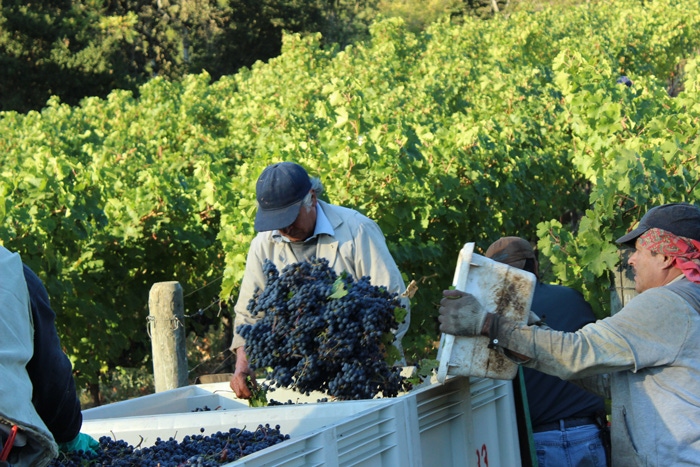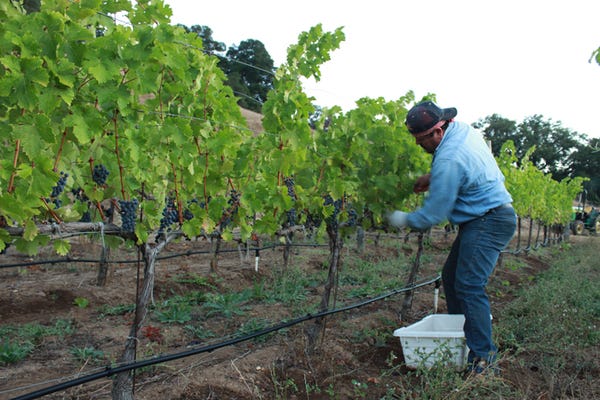
Workers harvesting grapes at Trefethen Family Vineyards, located in the Oak Knoll District at the southern end of the Napa Valley, aren’t getting their typical break between varieties this year.
Just five days after they completed picking the Chardonnay on Sept. 9 – the earliest finish for that variety in the Vineyards’ 45-year history – they starting pulling fruit from stands of hillside Cabernet Sauvignon as well as the Vineyards’ other later maturing varieties, Cabernet Franc, Merlot and Malbec.
Usually, Trefethen’s crews have a week or two breather between the end of the earlier-maturing grape harvest and start of harvest of the later varieties.
“We can have years when we start harvesting in one area due to a light crop in a young block,” says Jon Ruel, Trefethen’s CEO. “But this year everything has been ready early and ripening up quite nicely and quickly. Once we started picking Chardonnay, we’ve been running at a steady pacing, harvesting grapes five to six days a week.”
Earlier in the season, this year’s crop was developing about three weeks faster than usual. The grapes maintained this pace right up to Aug. 14th, when workers began picking the first ripe blocks of Chardonnay. By the time they had pulled the last Chardonnay grapes off the vines, the crews had already completed their harvest of Pinot Noir, Riesling and Sauvignon Blanc.
As things looked in the middle of September and assuming no glitches, Ruel expects Trefethen’s 2015 harvest will be over by the first week of October. Typically, the harvest doesn’t reach that milestone until around Halloween.
“We’re thrilled about the quality of the grapes this year due to the warm, sunny summer weather,” says Ruel, who served as president of the Napa Valley Grapegrowers from June, 2012, to June, 2014. “The crop is coming in tasting great. Everyone is excited about the flavor and chemistry.”
Such enthusiasm, however, doesn’t carry over to the quantity of grapes being harvested. Tonnage from his Chardonnay and Pinot Noir blocks fell about 20 percent short of target yields, he reports. Meanwhile, yields from his later-blooming Cabernet Sauvignon and Merlot are running only about 10 percent below earlier projections.
“Across the Napa Valley, growers at many vineyards are talking about the wide variability in set in all varieties,” says Ruel. He traces that back to cooler-than-average temperatures in the spring. On Trefethen’s ranch in the Oak Knoll District’s cool conditions, the Chardonnay and Pinot Noir vines were impacted but the Cabernet Sauvignon bloom caught a stretch of warmer weather.”
This difference affected the way Ruel managed the vines this year. Anticipating a smaller crop, his crews did minimal cluster thinning in the blocks of Chardonnay and other earlier-blooming varieties to leave more fruit. However, because of the improved set in the Cabernet Sauvignon and Merlot, those clusters were thinned at the usual rate, he says.
Meanwhile, the on-going drought limited berry and cluster sizes this season, Ruel adds. Although his records show that his vineyards received 82 percent of the normal rainfall between July 1, 2014, and June 30, 2015, almost all of that fell in December of last year.
“Even with our drip irrigation system, we can’t replicate the full-saturated soil profile that results with natural rainfall,” Ruel says. “This year our cover crops and weeds had already been taking up water from the December rains. So, by the time the vines started growing in the spring, the soils were pretty dry.”
This year’s smaller berries, which reduce the amount of juice to make wine, are a disappointment for Chardonnay growers, he notes. But, he considers undersized fruit a blessing for Cabernet Sauvignon and Pinot Noir fans. “The tannins and other phenolics are all in the skin and seeds,” he says. “So the smaller berries make for very strong and concentrated flavors in the wine.”
Since 2005, when their last block of vines was put in with vertical shoot positioning trellises, all new plantings at Trefethen Family Vineyards have featured horizontally-divided canopies. It’s part of a long-range plan of adjusting Trefethen’s viticultural practices to deal with a warming climate.
Despite the 2013 and 2014 seasons when Napa Valley enjoyed favorable summer weather for ripening grapes, he cautions against becoming complacent about mild summers.
“We need to remember that we can get some very strong heat spells in the Valley,” he says. “This summer was definitely warmer than the past two. In both the first part of this month and in the middle of last month, we had serious heat spells, when temperatures here rose above 100 degrees.
“Under such conditions, ripe, soft grapes are quite vulnerable to dehydration, especially with a VSP trellis, which exposes some fruit to sun damage. Using a quadrilateral cordon to divide the canopies horizontally can reduce the risk of dehydration.”
Choice of root stock also plays a role in Trefethen’s preparations for a warmer, drier climate. Now, instead of planting low-vigor root stock, like 101-14, with its shallower root system that requires more frequent irrigation, Ruel is planting deeper-rooted 110R and St. George rootstock that can handle drought conditions better.
This year, in keeping with Trefethen’s practice of minimizing use of herbicides, Ruel replaced a worn-out implement, which uses a subsurface knife to cut weed roots, with a new, updated version. He uses the tractor-drawn tool to control weeds mechanically between and within the vine rows. It features a hydraulic arm that automatically retracts the knife when it detects a vine to prevent damaging the vine.
This year, he and other Napa Valley growers have been on the alert for signs of Pierce’s Disease in their vineyards. This follows a flare-up of Pierce’s disease in some Napa Valley vineyards last year and even more reports this season, Ruel notes. The typical management regime includes controlling the blue-green sharpshooter, historically the most important vector of this bacterial disease in the Napa Valley and other coastal areas of California.
“Due to the extent of Pierce’s disease we’re seeing around the Napa Valley, we don’t know if we’re fighting another vector of if drought or some other factor has changed the behavior of the blue-green sharpshooter,” Ruel says. “But, we’re no longer finding the disease just near riparian areas. Now, we’re also seeing it in the middle of vineyards.”

Eleuterio Gonzales, a veteran on the estate's farming crew, picks Cabernet Sauvignon at Trefethen's Hillspring vineyard on September 16. Photo by Reza Ruel
About the Author(s)
You May Also Like




